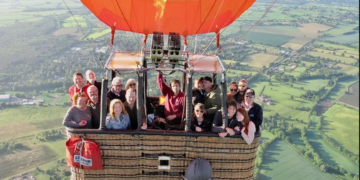Introduction to Brae Kmecheck and his artistic journey
Art has always been a reflection of the times, but in today’s digital landscape, it takes on new dimensions. Enter Brae Kmecheck—a visionary artist whose journey through creativity is as captivating as his work. With a background that intertwines traditional techniques and modern technology, Kmecheck stands at the forefront of artistic expression in the 21st century. From mesmerizing digital pieces to interactive installations, he challenges our understanding of what art can be. Join us as we explore how Brae Kmecheck redefines artistic boundaries and navigates this thrilling evolution in the world of art.
The Evolution of Art in the Digital Age
The digital age has transformed art in ways once unimaginable. Traditional mediums have made room for innovative expressions that challenge the norms. Artists now embrace pixels, algorithms, and virtual spaces.
This evolution redefines creativity. No longer confined to canvas or clay, art can manifest as immersive experiences. Audiences engage with interactive pieces that respond to their presence.
Software tools empower artists like Brae Kmecheck to experiment freely. They blend photography with graphic design and animation seamlessly. Each click opens new avenues for exploration.
Accessibility is another game changer. Art transcends geographic boundaries through online platforms and social networks. Emerging talents gain visibility without traditional gatekeepers dictating terms.
As technology advances, so does the definition of artistry itself. The lines blur between creator and audience as everyone becomes a participant in this vibrant landscape.
How Brae Kmecheck Utilizes Technology in His Art
Brae Kmecheck seamlessly integrates technology into his artistic practice. His work often features digital tools that enhance creativity and expand possibilities.
Using software like Adobe Creative Suite, he manipulates images in innovative ways. This allows him to create stunning visual narratives that resonate with a modern audience.
Kmecheck also experiments with augmented reality (AR). This technique invites viewers to engage with art through their smartphones, creating an interactive experience unlike traditional galleries.
He frequently shares his process on social media platforms. By doing so, he demystifies the creation of digital art and encourages aspiring artists to explore tech-driven techniques themselves.
Moreover, Brae’s use of 3D printing showcases how technology can materialize ideas previously confined to screens. Each piece reflects a unique fusion of craftsmanship and digital innovation.
The Impact of Social Media on Artistic Expression
Social media has revolutionized how artists share their work. Platforms like Instagram, TikTok, and Pinterest provide instant access to a global audience. For creators like Brae Kmecheck, this exposure is invaluable.
Artists can showcase their creative processes through behind-the-scenes content. Viewers witness art evolving in real time, fostering deeper connections with the artist’s journey.
Moreover, social media allows for diverse feedback. Comments and likes can inspire new directions or validate existing efforts. This interaction cultivates a sense of community among artists and fans alike.
However, the pressure to constantly produce can be overwhelming. Artists may feel compelled to conform to trends rather than pursue authentic expression.
Despite these challenges, social media undeniably amplifies artistic voices that might otherwise go unheard. It democratizes art by allowing anyone with talent and passion to share their vision with the world.
Breaking Barriers and Pushing Boundaries: Brae Kmecheck’s Unique Style
Brae Kmecheck stands at the intersection of tradition and innovation. His unique style is a fusion of classic artistic techniques and cutting-edge technology.
Each piece challenges conventional norms, inviting viewers to explore deeper meanings. Kmecheck’s work often incorporates augmented reality elements, enhancing the visual experience beyond what’s on canvas.
He employs vivid colors and dynamic patterns that seem to leap out at the audience. This ability to blend physical art with digital experiences sets him apart in a crowded field.
Kmecheck doesn’t shy away from controversial themes either. He addresses societal issues through his art, pushing boundaries that many artists fear to tread.
In doing so, he encourages dialogue among audiences. This approach not only redefines personal expression but also expands the conversation around what art can be in today’s world.
Criticisms and Controversies Surrounding Digital Art
Digital art has sparked heated debates within the creative community. Critics often argue that it lacks the authenticity of traditional mediums. They claim that the ease of manipulation diminishes artistic integrity.
Moreover, some believe digital artists rely too heavily on technology. This perception can lead to a dismissive attitude toward their skills and creativity. Many traditional artists voice concerns over losing their place in an increasingly digital world.
Controversies also arise with issues like copyright infringement. The internet makes sharing work simple, yet it blurs ownership lines. Artists face challenges protecting their creations from misuse.
Despite these criticisms, digital art continues to thrive and evolve. It invites new voices while challenging conventional norms in artistry, ensuring a lively dialogue about its role in contemporary culture.
The Future of Art: Will Technology Continue to Shape It?
As we look ahead, the intersection of art and technology continues to expand. The pace at which digital tools evolve suggests that artists like Brae Kmecheck will keep redefining what it means to create. Virtual reality, augmented reality, and artificial intelligence are not just trends; they promise new dimensions for artistic expression.
For many artists, the canvas is no longer limited to paint on a surface. Instead, it’s becoming a complex tapestry woven from code, data, and interactive experiences. This shift invites audiences into a dialogue rather than merely observing from afar. It transforms passive viewers into active participants in the creative process.
What lies beyond today’s innovations? As more creators adopt these emerging technologies, the definition of art may continue to blur further. Artists such as Brae Kmecheck challenge traditional norms and inspire future generations with their adaptability.
The question remains: how far will this journey take us? Will artists abandon conventional methods entirely or find ways to merge them with cutting-edge solutions? As technology advances relentlessly forward, one thing is certain—the future of art promises endless possibilities for exploration and expression that captivates both artist and audience alike.





































